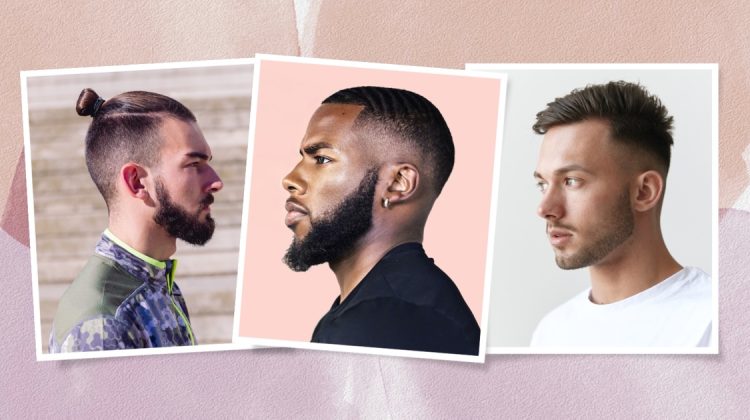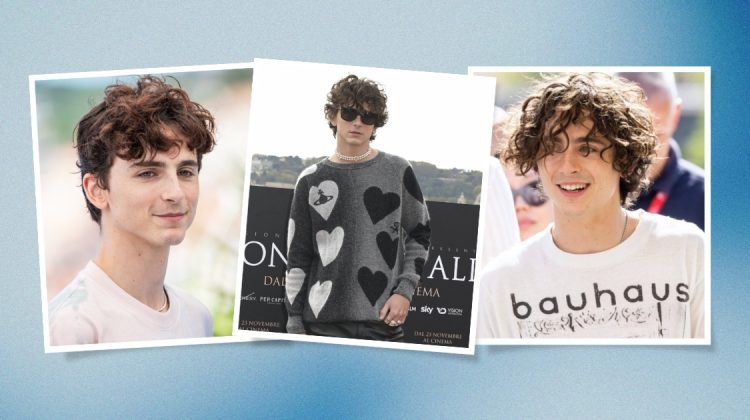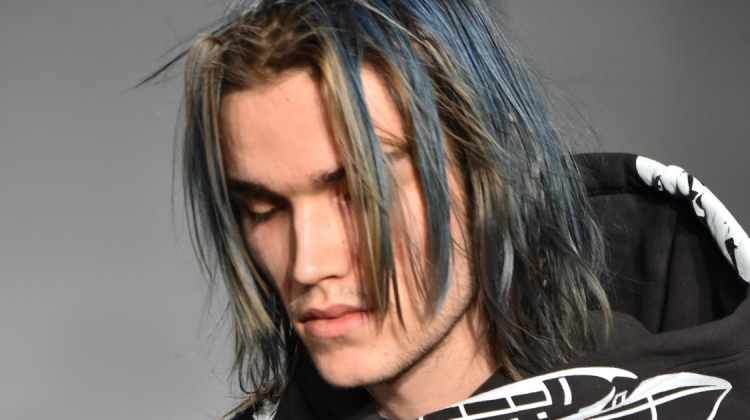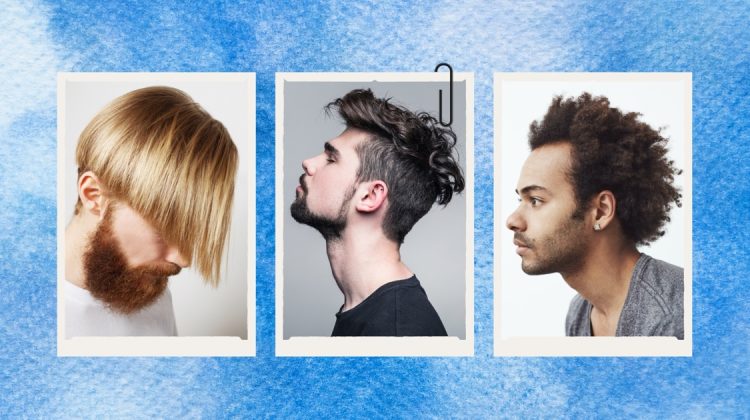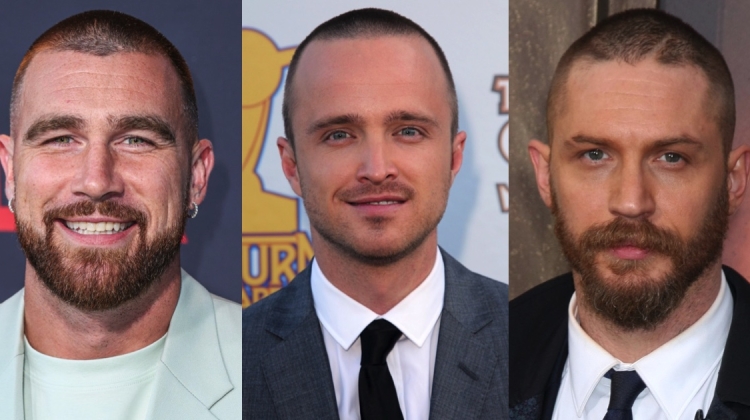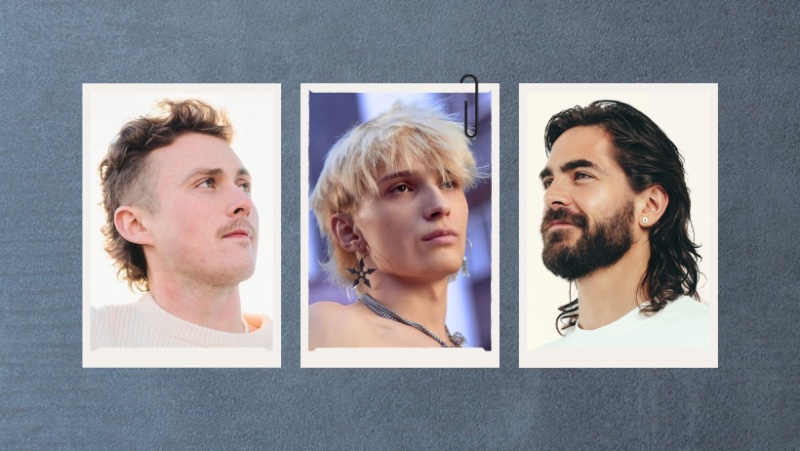
The mullet haircut for men, a rebellious long hairstyle, symbolizes bold identity and unapologetic confidence. Characterized by its shorter front and sides and longer back, the modern mullet has been embraced and adapted by men in the United States, turning it into a global phenomenon.
Modern Mullet Haircuts for Men: Popular Styles
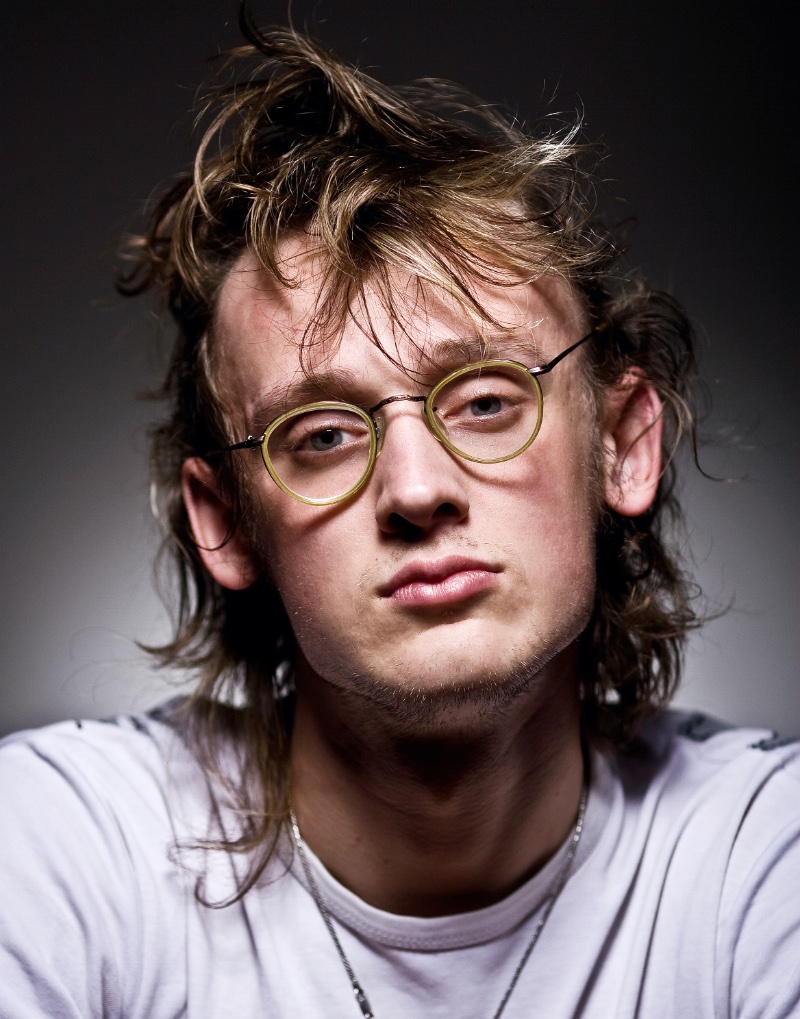
Today’s mullet styles adapt to various narratives, offering an excellent mode of self-expression. The range of types of mullets, from the classic unrefined cut to the new age mullet, keeps the iconic haircut fresh.
Modern Mullet Fade
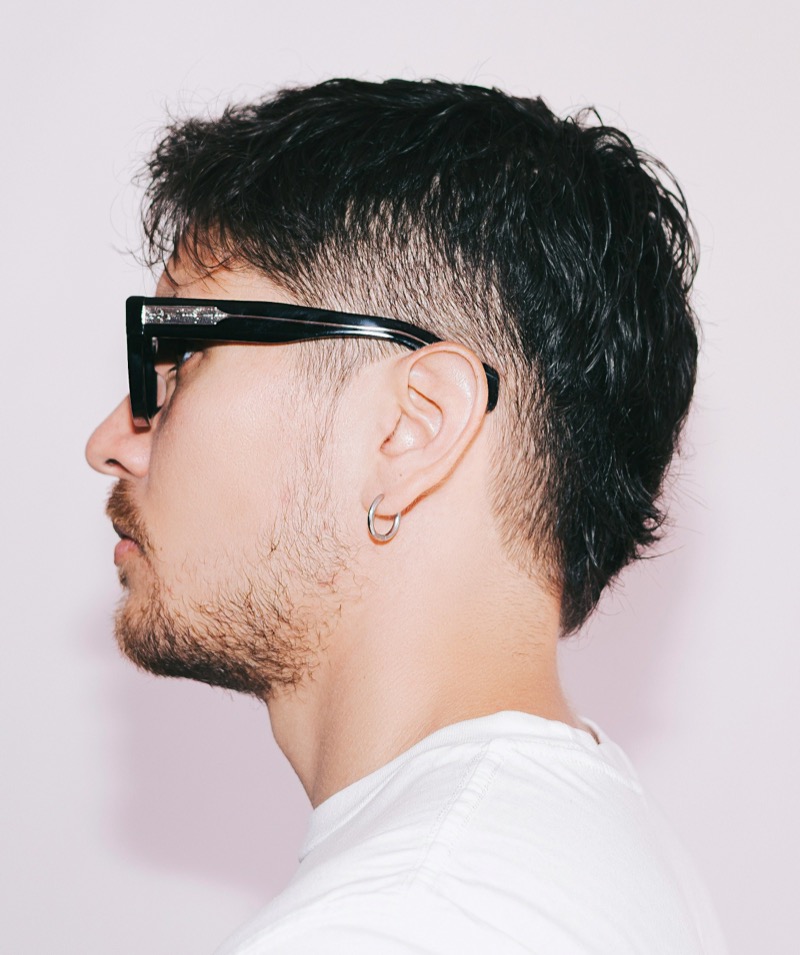
A modern mullet fade blends the length of a mullet with the close sides of a fade. The sides are tapered down to the skin, setting up a clean canvas for the top and back to shine.
The top keeps natural texture and a relaxed finish, flowing into longer hair at the nape. To maintain the shape of the short mullet fade, work in a matte clay or cream, letting the back move with ease while the faded sides keep the profile fresh.
Straight Hair Mullet
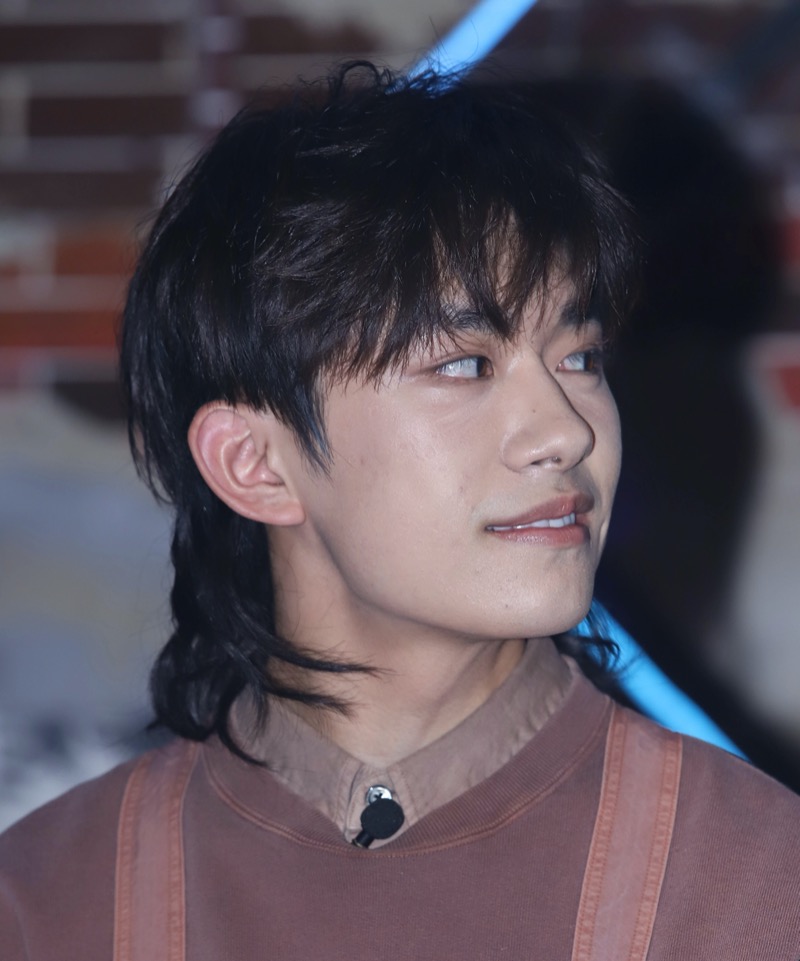
The straight hair mullet keeps the top and sides tidy, with a relaxed flow that leads into length at the nape. The straight texture turns the mullet into a sleek statement, taking cues from ’80s rockers and Japanese street style. Here, a touch of lightweight styling cream can keep flyaways in check and show off the movement.
Taper Fade Mullet
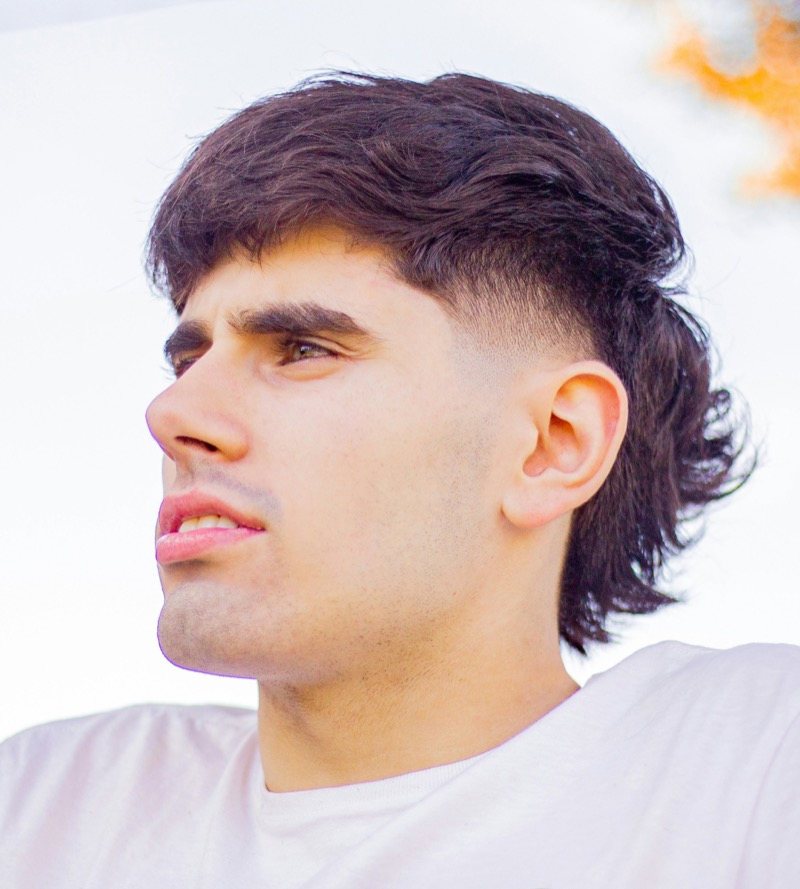
A taper fade mullet thrives on contrast, matching the shape of a traditional mullet with the clean lines of a barbered fade. The sides feature a gradual transition, whether you choose a low taper fade for subtlety or a mid taper mullet for a bit more edge.
Both approaches deliver a modern mullet taper fade that feels effortless, with the fade lifting the profile while the back remains untamed. The taper mullet fade offers flexibility, suiting a range of hair types from straight to curly, and looks especially current when styled with a matte cream to enhance texture.
Middle Part Mullet
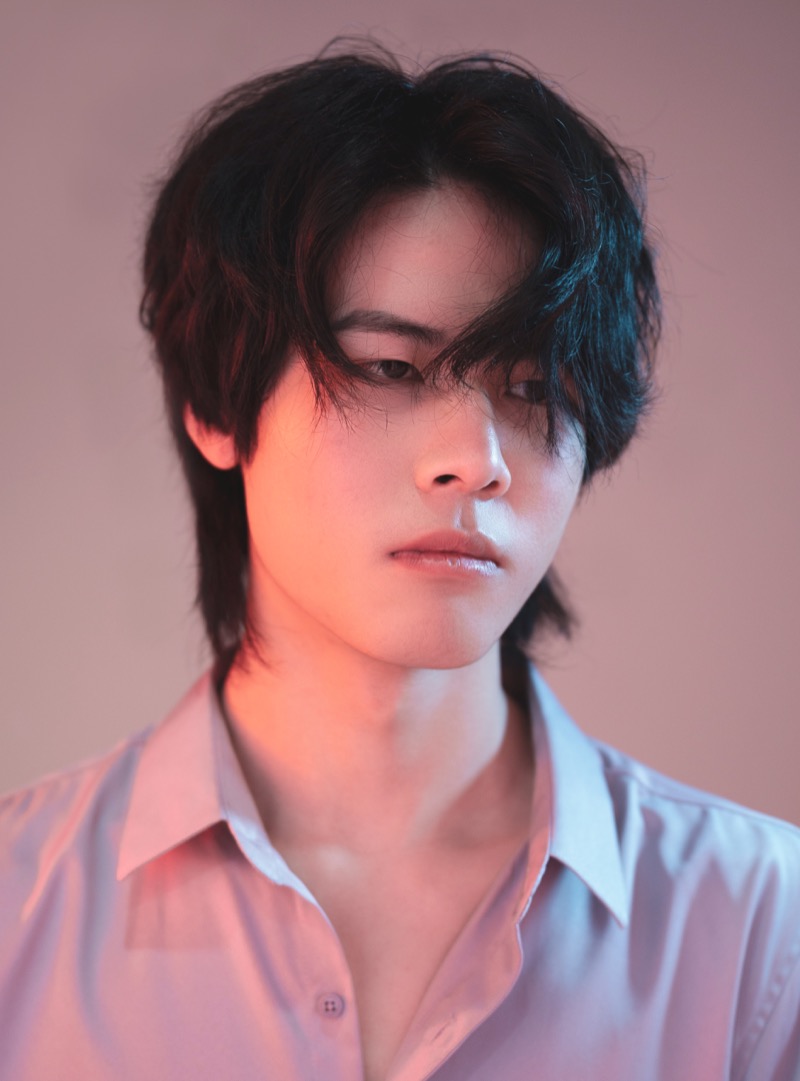
A middle part mullet puts a modern spin on the retro silhouette, blending face-framing layers with extended length at the back. The defined center part creates natural symmetry, letting hair fall evenly on both sides for a look that reads as a classy mullet.
The back keeps the mullet’s identity clear, while the parted front softens the overall look. Styling comes easy with a lightweight cream or serum to accentuate shine and movement.
Faux Hawk Mullet
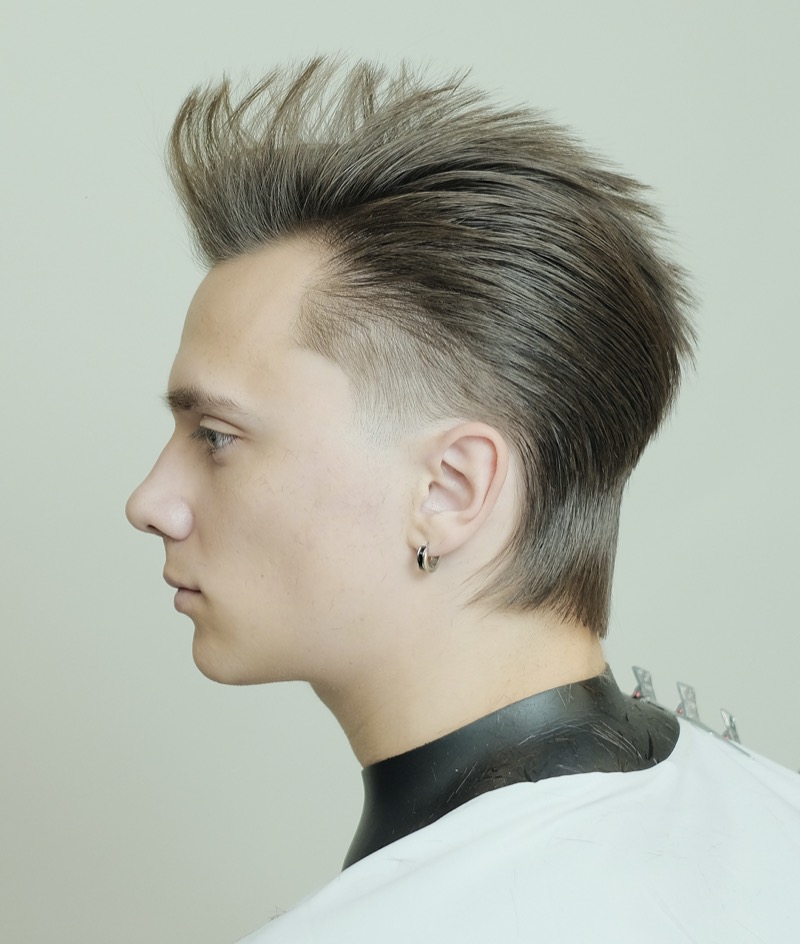
A faux hawk mullet puts a rebellious twist on two bold styles, combining the lifted center of a faux hawk with the signature length of a mullet at the back. The top hair is styled upward and slightly forward, drawing the eye to a sharp ridge, while the sides are kept shorter for a clean outline.
The mullet’s back section stays long, lending extra attitude. Styling is simple: a strong-hold wax or pomade helps keep the faux hawk defined and the length at the back controlled.
Curly Mullet
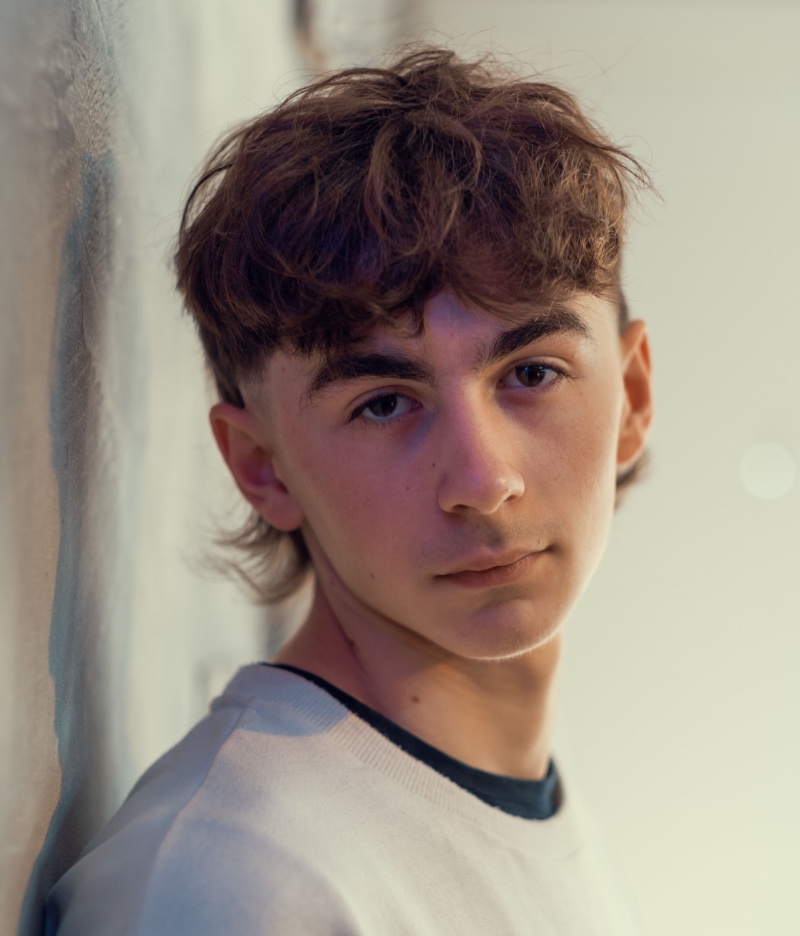
The curly mullet is a fresh take on the traditional style that adds a playful twist with its natural curls. This version embraces the inherent texture of curly hair, allowing the curls to form a soft, tousled canopy over the head while the hair at the back cascades down in a more controlled flow.
The contrast between the curly hair at the top and the smoother lines of the lengthier back portion perfectly embodies the men’s modern mullet. A light curl-enhancing product may be applied to maintain the curls’ shape.
Mullet Two Block Haircut
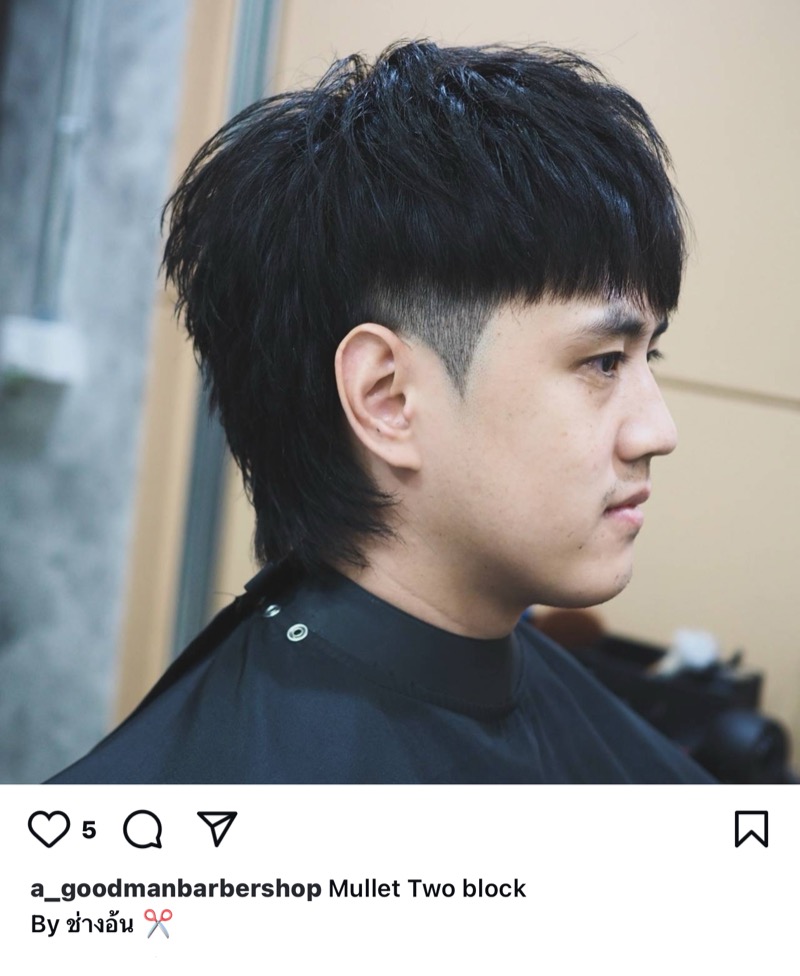
A mullet two block haircut stands out for its sharp contrast, featuring a disconnected undercut at the sides and a heavy, textured top that flows into longer length at the back. This style draws influence from Korean street trends and anime, blending the clean shape of a two block with the signature mullet silhouette.
The sides are clipped tight, while the top remains thick and bold, creating a dramatic difference. A lightweight styling wax or pomade helps define the shape and adds extra separation.
Short Mullet Haircut
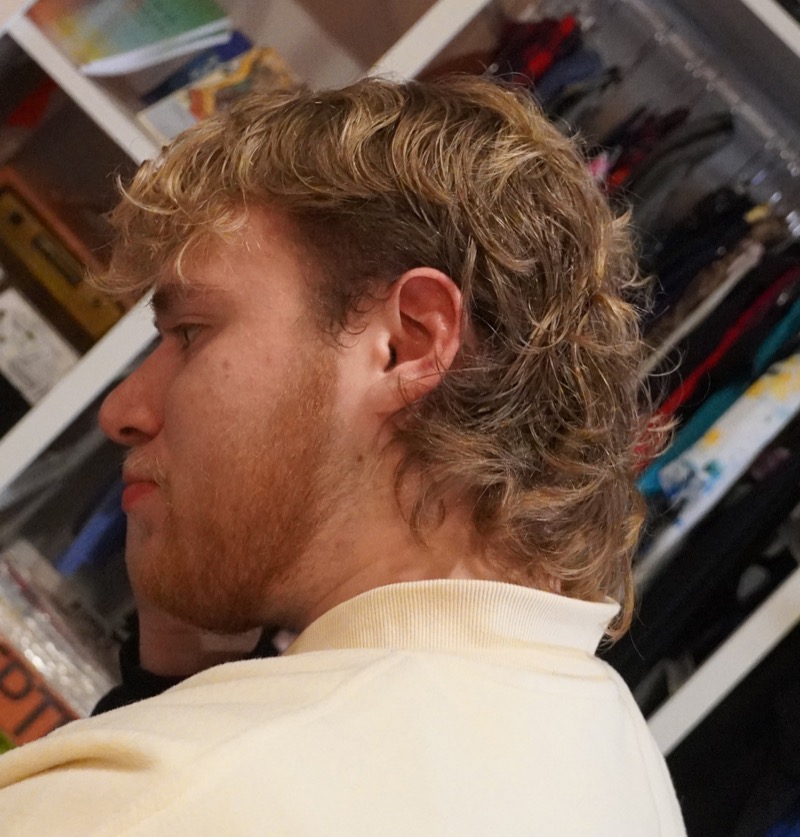
A short mullet haircut refines the signature business-in-the-front, party-in-the-back look for everyday wear. The sides and top stay trimmed, keeping the focus on subtle shape instead of dramatic contrast, while the back maintains enough length to hint at the cut’s rebellious origins.
This version trades the exaggeration of the classic mullet for softer lines. For those after low-maintenance edge, a light texturizing product works well.
Fringe Mullet
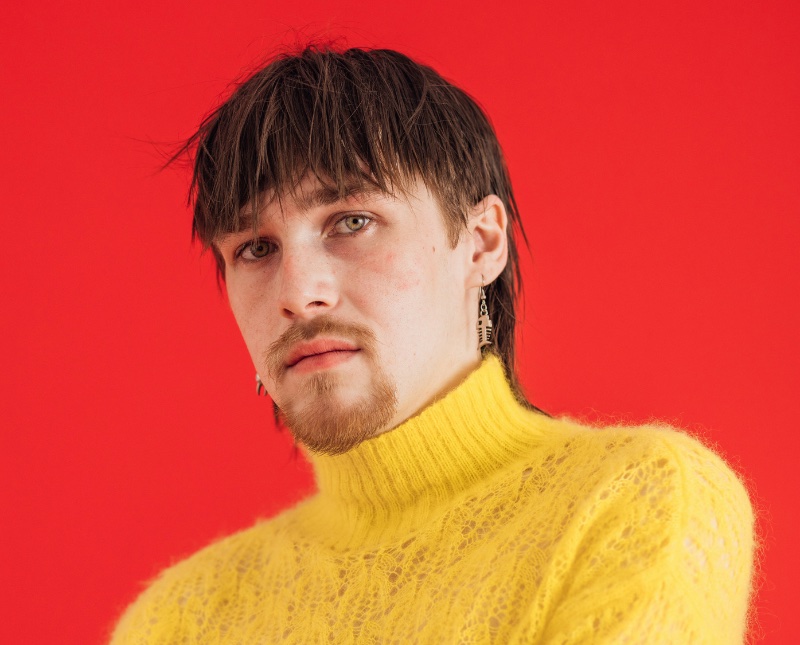
The fringe mullet modernizes the classic mullet with a choppy fringe, adding a fresh, edgy look to the timeless cut. The fringe, textured and falling casually over the forehead, introduces an element of grunge that plays well with the mullet’s intrinsic nonchalance.
The hair at the back retains the signature length, but the unstructured bangs give this style a contemporary twist. Styling this straight hair mullet might involve a light application of hair wax or pomade to enhance the texture of the fringe. In contrast, the remaining hair is more natural to emphasize its movement and volume.
Medium Mullet
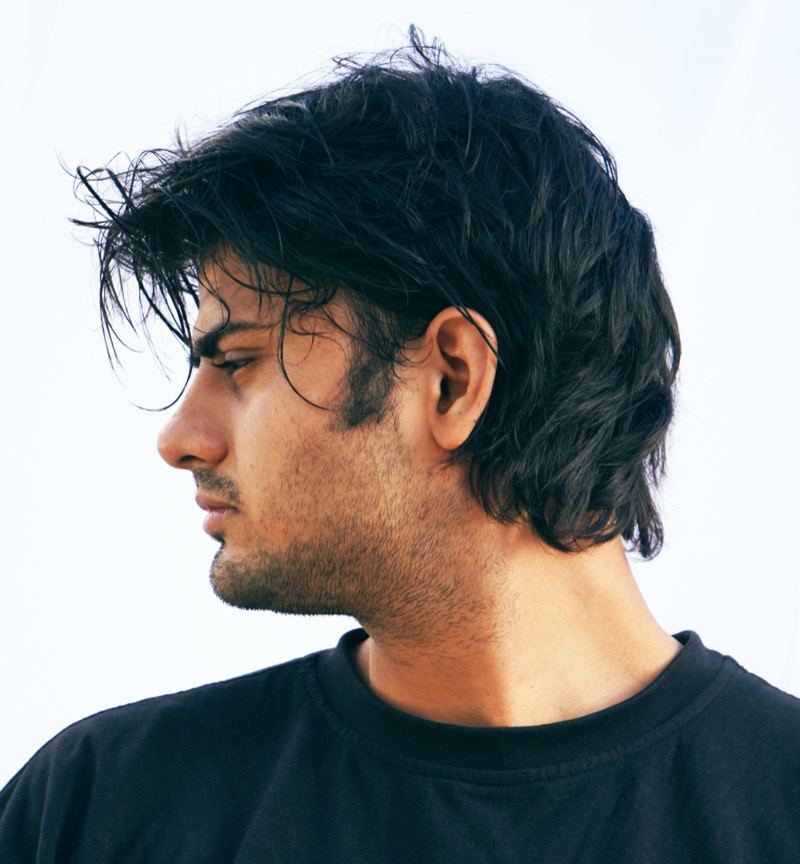
A medium mullet offers a balanced take on the iconic shape. The top and sides are layered, while the back carries enough length to signal the classic mullet.
This version works well with natural texture, giving the hair room to move and fall into place. A bit of sea salt spray or lightweight mousse can boost definition.
Shaggy Mullet
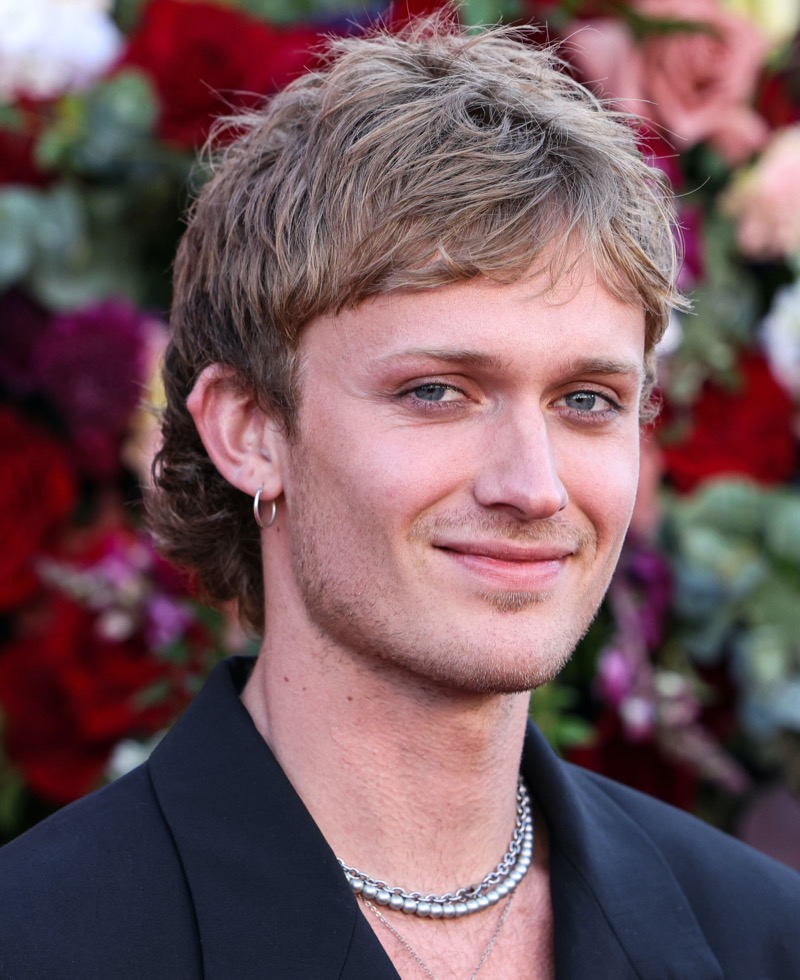
A shaggy mullet brings together layers, movement, and a laid-back attitude. The top and sides stay textured and choppy, with the fringe falling loose across the forehead and the back left a little longer for that iconic mullet shape.
This choppy mullet style draws from the free spirit of ‘70s rock and the undone attitude of indie fashion. Light styling cream or sea salt spray keeps the layers soft and the finish easy.
Burst Fade Mullet
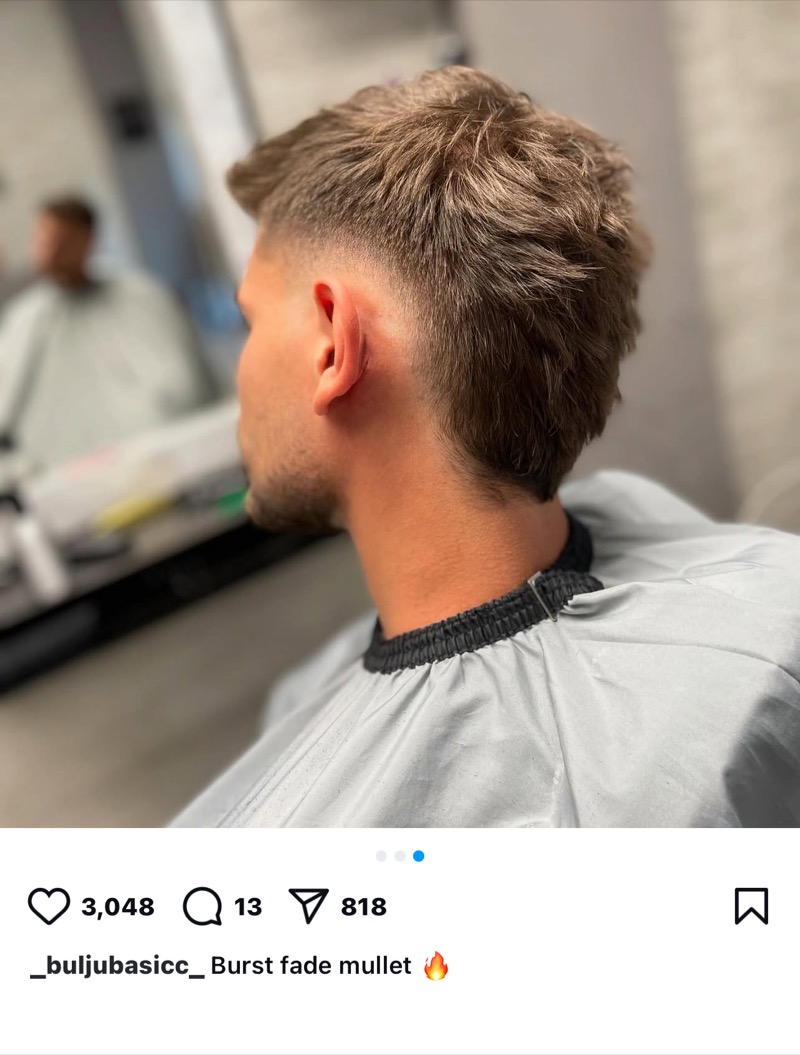
The burst fade mullet updates the mullet playbook with a burst fade that curves cleanly from the temple down to the neckline, highlighting the shift from close-cropped sides to textured fullness. The burst fade creates a sharp semicircle that gives the cut fresh energy.
The longer back keeps things true to the mullet’s rebellious legacy, while the fade’s precision makes the look current. A touch of lightweight styling powder or matte paste adds separation and movement.
Messy Mullet

A messy mullet turns natural texture and volume into a statement, combining tousled layers on top with a longer, unstructured back. This fluffy mullet style thrives on imperfection, drawing from the attitude of punk and the free-spirited energy of the wolf cut.
The silhouette stays loose and lived-in, letting waves or curls create body and movement. A light mousse or sea salt spray can boost definition, making the most of the cut’s playful shape.
Flow Mullet Haircut
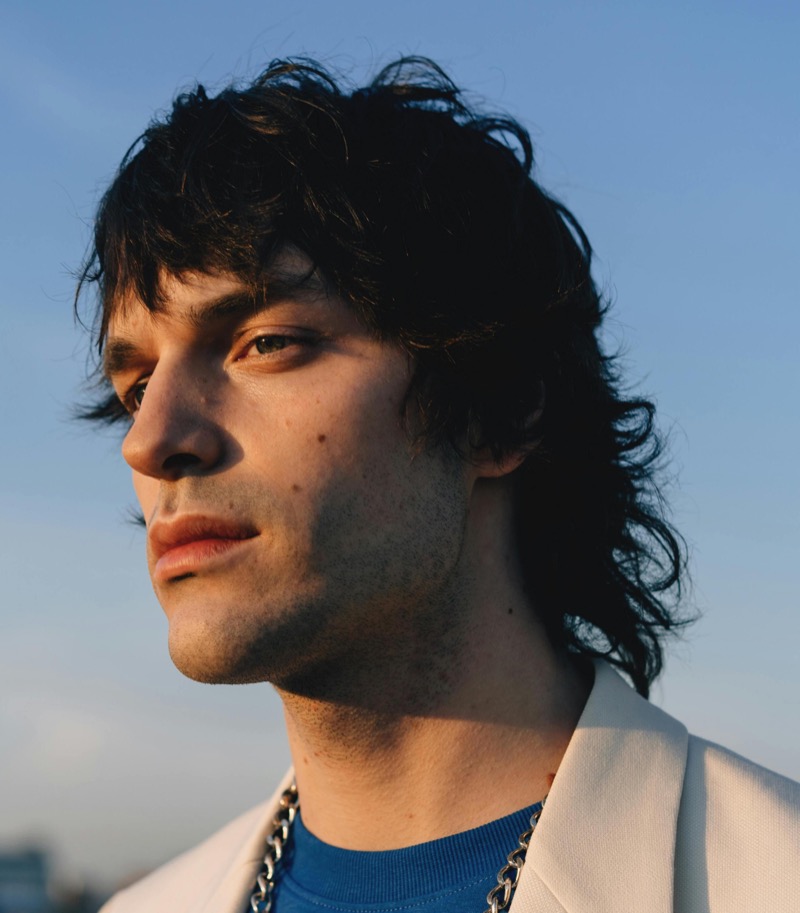
A flow mullet blends the laid-back vibe of a flow haircut with the bold silhouette of a mullet. Layers create volume through the top and back, while the sides stay loose, letting waves or curls fall into place.
The modern mullet flow works for all hair types but shines on textured or curly hair, where every turn of the head creates shape and movement. A curly flow mullet, in particular, brings extra dimension and softness, turning the classic mullet into something fresh.
Curly Mullet Fade
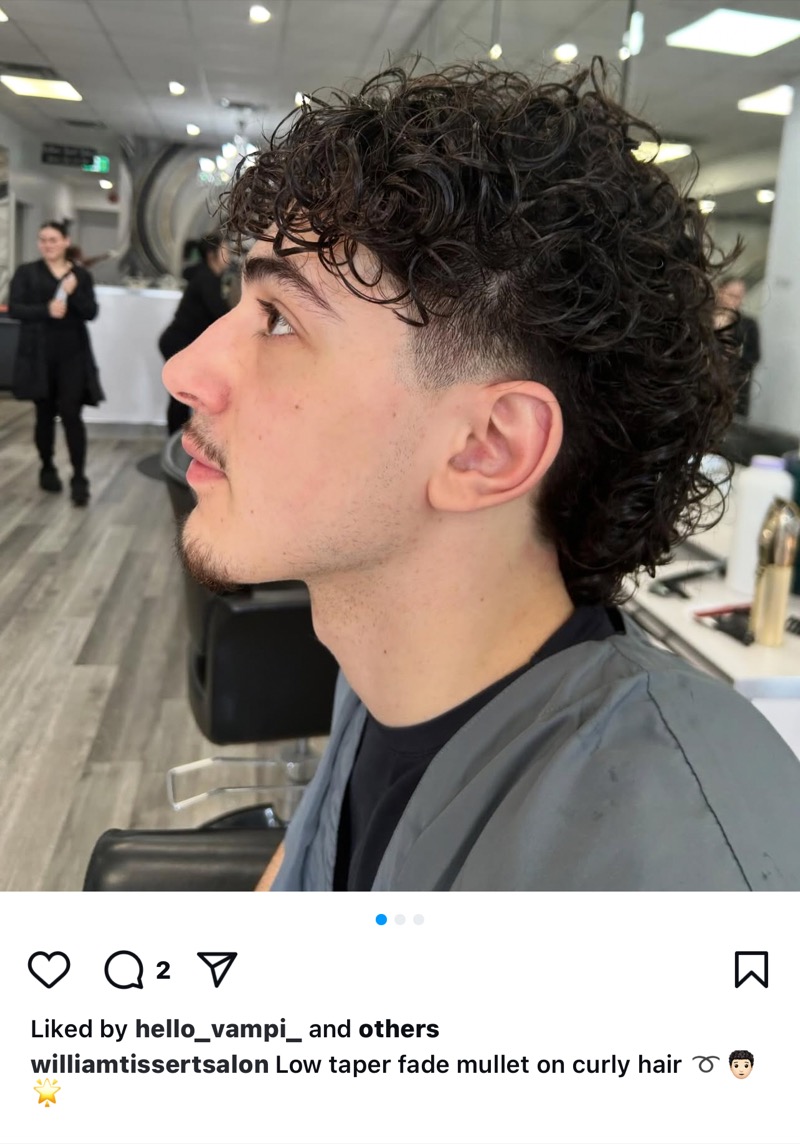
A curly mullet fade turns natural texture into the main attraction, blending a low taper fade with volume on top and length at the back. The sides stay clean and sharp, fading neatly around the ears, while the curls create movement from the fringe to the nape. Styling comes easy with a curl cream or light mousse to bring out definition and keeps the curls soft.
Old School Mullet
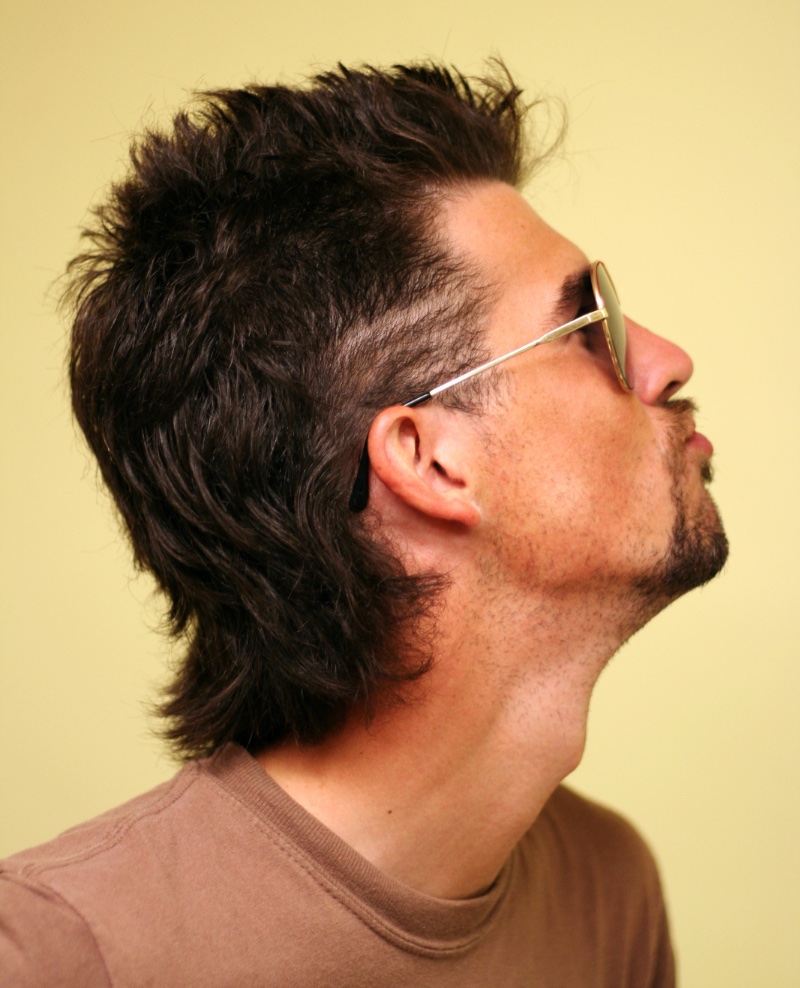
An old school mullet stands out for its unmistakable contrast: short sides, a full crown, and long, bold length at the back. This version brings heavy volume up top, channeling the fearless energy of the late ’70s and ’80s when rock stars and rebels made the mullet their signature.
The silhouette pushes the difference between business and party to the limit, making every angle distinct. Classic styling moves like a blow dryer for lift and a touch of mousse help keep the shape dramatic and true to its roots. This style is also easily transformed into a spiky mullet.
Permed Mullet
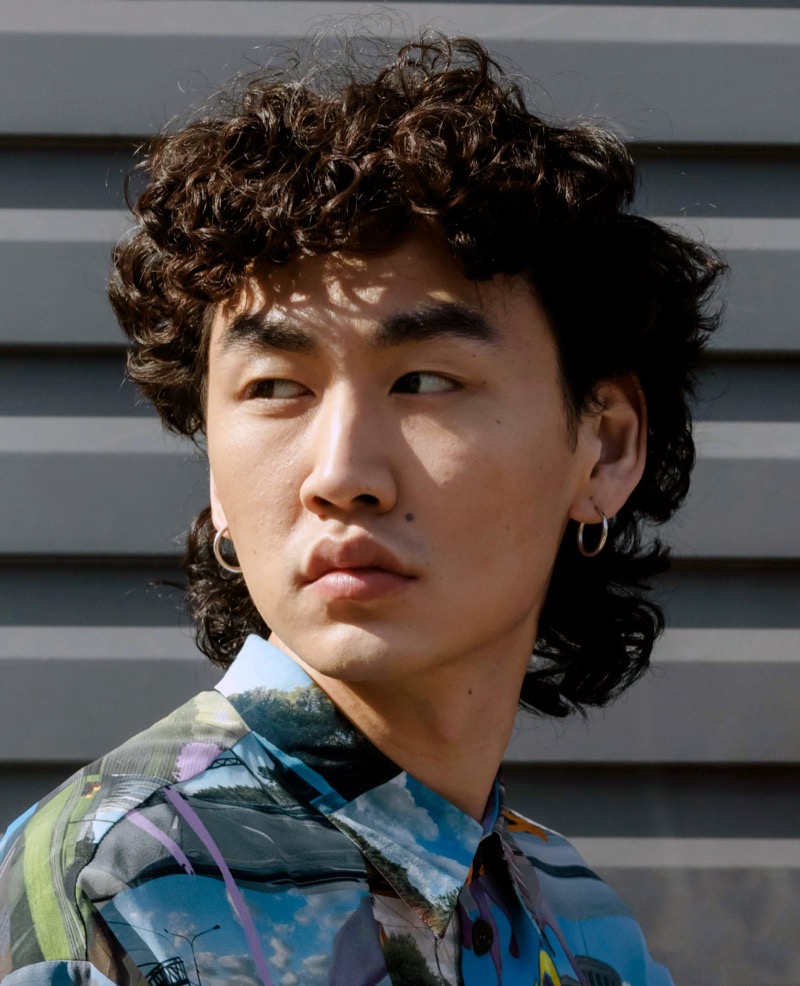
A permed mullet amplifies texture, turning classic lines into something full of character. Curls add volume up top and at the back, while the mullet’s signature length keeps the cut bold.
This look borrows from both vintage and modern influences, with roots in ‘80s glam and a strong presence in today’s K-pop and street style. A bit of curl cream or mousse enhances the shape, helping the curls keep definition while letting the back flow naturally.
Modern Mullet
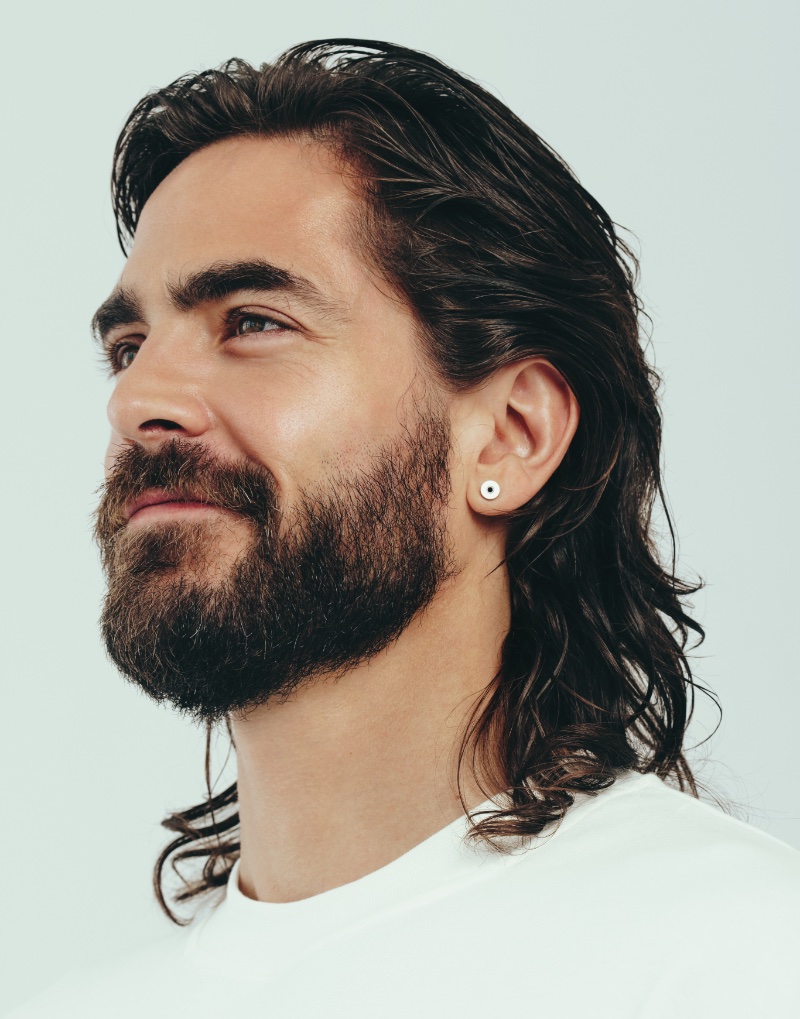
The modern mullet is a reimagined take on a classic style that seamlessly blends tradition with a touch of modernism. Modern mullets maintain the characteristic long hair at the back but adds more texture and volume up top, moving away from the stark contrasts of its predecessors.
Stylists often use scissors and a hair clipper to create a graduated, layered hair effect that flows into the length at the nape. The front and sides are typically styled with hair wax or pomade to achieve a sleek, controlled look that contrasts the more relaxed vibe of the back.
Tapered Mullet Haircut
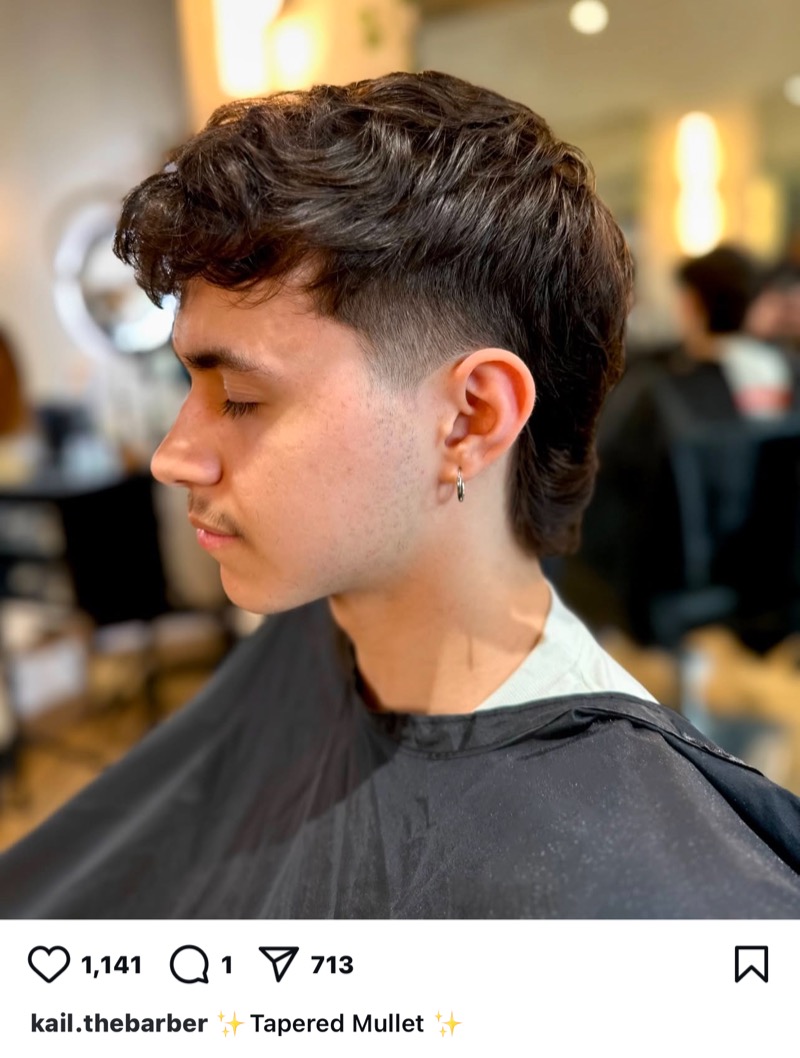
A tapered mullet haircut features a gradual blend at the sides and natural texture up top. The taper softens the transition from short around the ears to longer length at the nape. Layers on top bring out movement, while the signature back length keeps the look rooted in mullet territory.
This style works well for wavy or straight hair, staying true to the spirit of retro cuts. A little styling cream or texturizing spray helps keep the taper defined and the layers lively.
Skin Fade Mullet with Fringe
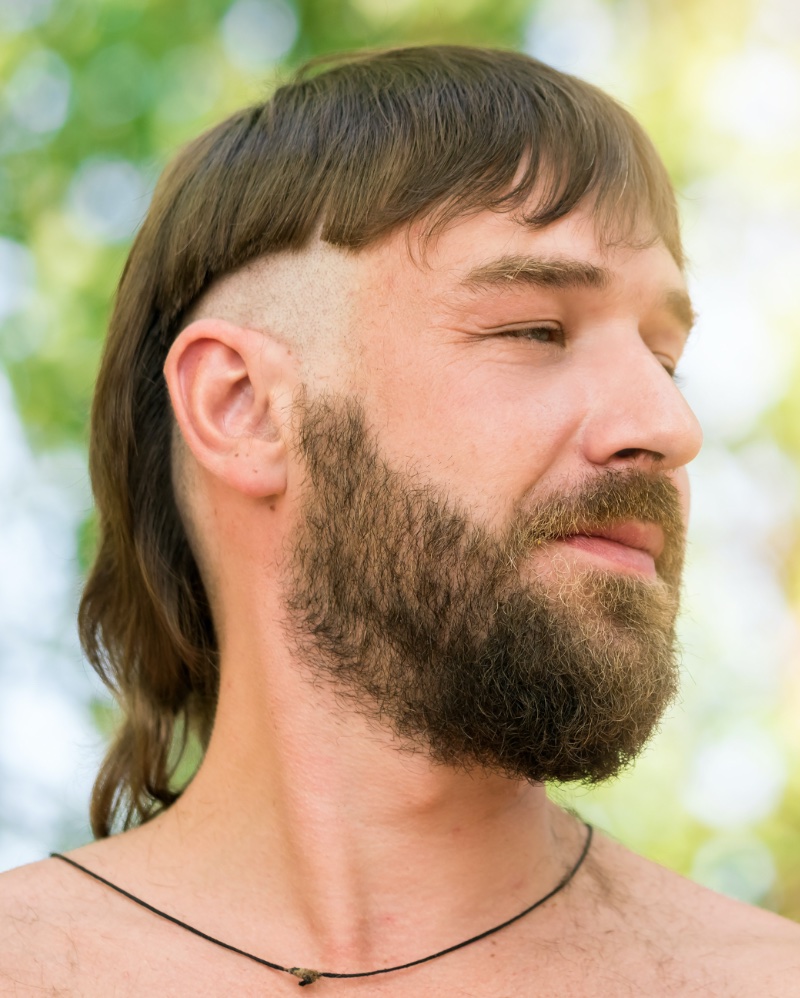
A skin fade mullet with fringe pushes the envelope, combining two strong trends into one statement cut. The sides are shaved down to the skin, creating a dramatic faded mullet effect that makes the length at the back pop even more.
Up front, a textured fringe drops low over the forehead, softening the attitude. Daily styling stays straightforward with a dab of lightweight styling cream or wax to shape the fringe, while the faded sides and longer back hold their own.
Mohawk Mullet
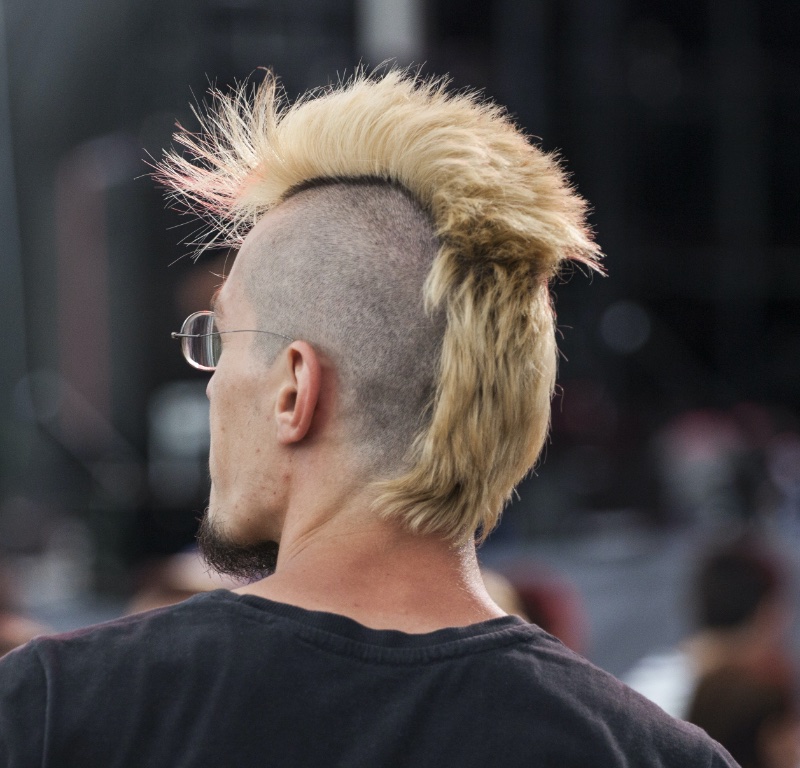
The mohawk mullet is a dynamic blend of the mullet and the mohawk, delivering an audacious statement that channels the spirit of both hairstyles. It represents a unique subculture where the mullet’s party-at-the-back ethos meets the mohawk’s radical boldness.
The mohawk mullet’s sides are cropped close, often with a fade highlighting the stark transition to the spiked or tousled strip of hair atop the head. This centerpiece extends into the classic mullet fall at the back, creating a striking visual contrast that is modern and reminiscent of punk rock aesthetics.
For daily styling, a strong-hold product can help achieve the desired height and shape, ensuring the mohawk stands out confidently.
Spiky Mullet

A spiky mullet injects attitude into a classic shape, blending sharp, lifted spikes on top with the familiar length at the back. This style borrows from the chaos of late ‘90s pop culture — Brad Pitt’s hair in Fight Club stands as the ultimate reference, showing how a spiked mullet can deliver both edge and laid-back charm.
The top hair is worked up with a strong-hold gel or wax, while the back stays loose for contrast. The overall effect is messy but deliberate, landing right between punk inspiration and everyday wear.
Mullet Undercut
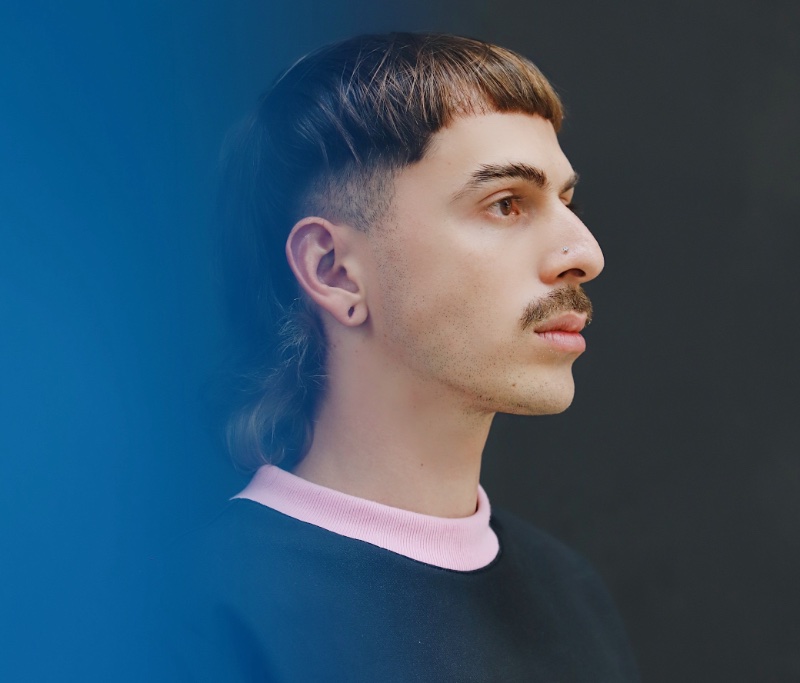
The mullet undercut for men reimagines the classic mullet with a sharp, contemporary edge. The hair at the front and sides is cut even shorter than the traditional style, while the back retains the iconic mullet length.
The juxtaposition of the closely cropped sides and the elongated back creates a striking, defiant profile. In this rendition, the top hair often features a subtle length, enough to style but short enough to contrast dramatically with the back.
The undercut mullet can be left natural for a softer appearance or styled with products for a more defined, standout finish.
Textured Mullet
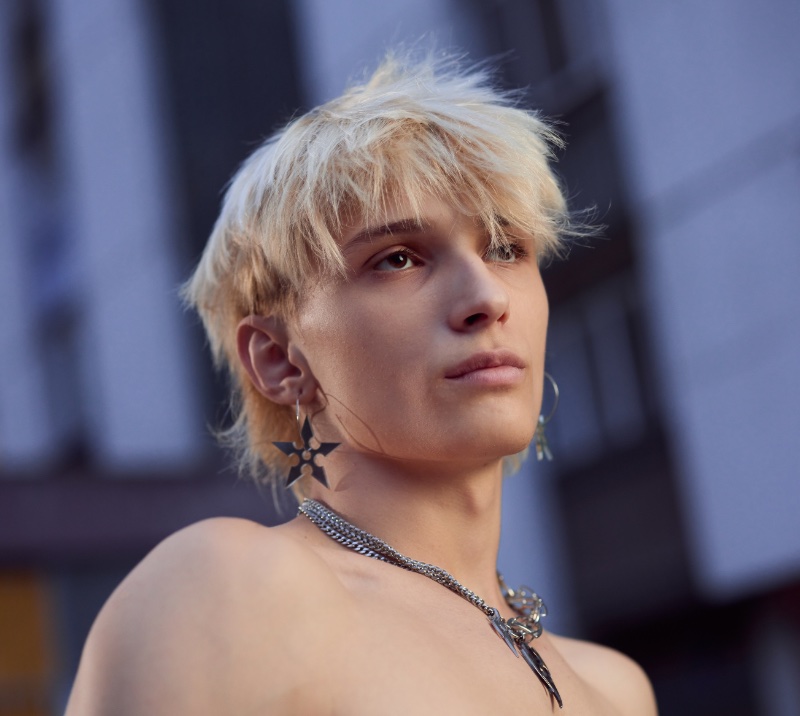
The textured mullet emphasizes creating a sense of depth and movement through varied lengths and styling techniques. The cut combines shorter layers at the top with the signature long hair at the back.
Stylists achieve this effect with careful trimming and sometimes thinning shears to add texture without reducing the overall volume. Light use of hair products like wax can define the layers to maintain the look, and the occasional use of a hair clipper for the edges keeps the style looking sharp.
Wavy Mullet

The wavy mullet is an ode to the flexibility of this iconic hairstyle, adapted for wavy hair textures. It features a naturally tousled top that transitions into a more relaxed, flowing back, allowing the hair’s inherent waves to add character and movement to the look.
Maintenance involves a light touch and minimal product use to define the waves and retain the hair’s natural volume. A trim now and then ensures the silhouette stays fresh, and the waves remain unburdened by excess length.
Temple Fade Mullet
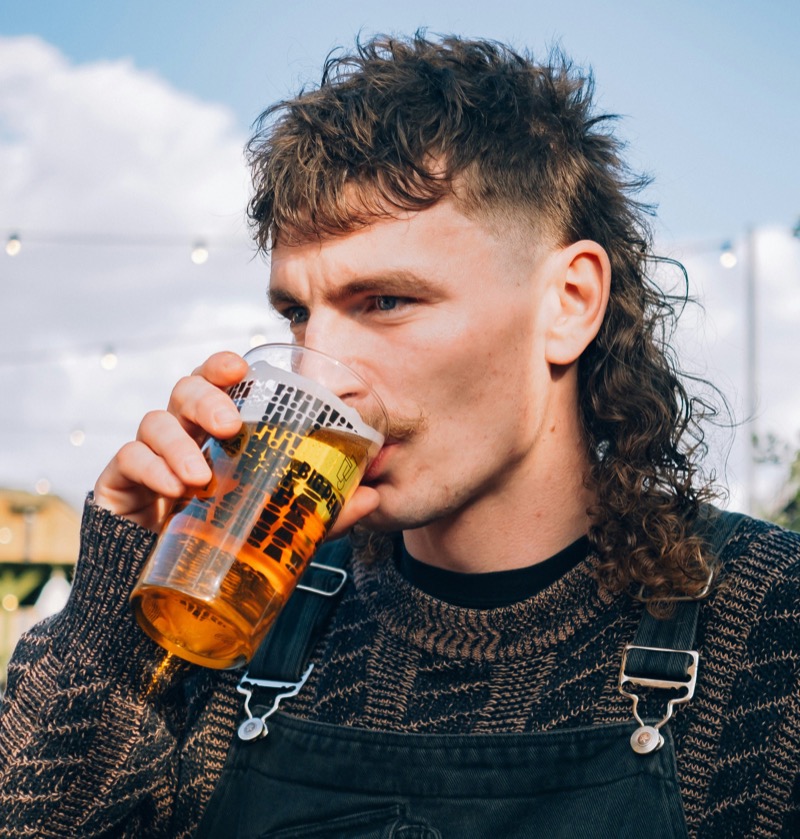
A temple fade mullet brings fresh energy to a classic cut, pairing tight faded sides at the temples with a textured top and a long, curly back. The sharp transition at the temple cleans up the outline, setting off the length at the nape.
This look works especially well for wavy or curly hair to keep some volume and flow. Styling is simple: a touch of curl cream keeps the back defined while the sides stay clean.
Wet Look Mullet
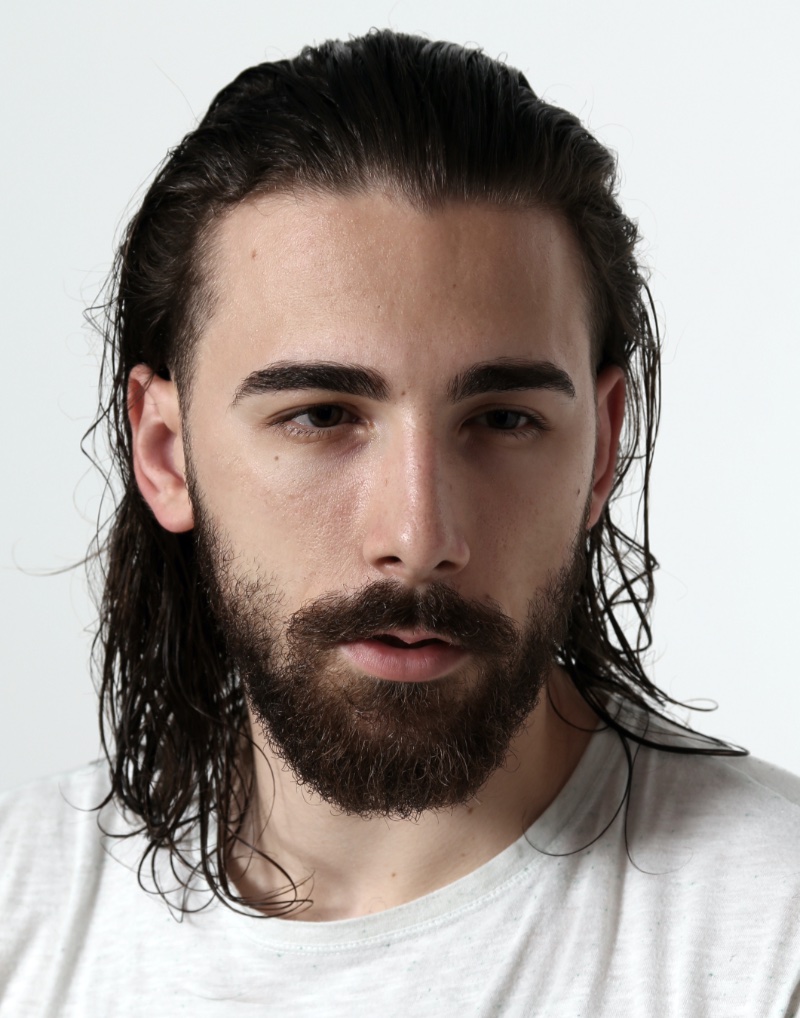
The wet look mullet highlights the hairstyle’s evolution and renewed relevance in contemporary fashion. As a bold variation of the men’s slick back haircut, it relies on pomade or hair wax to create a glossy, wet finish that defines the top.
Hair is combed back smoothly, forming a sleek surface that flows into longer, damp strands at the back. The contrast between the controlled slicked top and the casual fall of the long mullet gives the style its distinct edge.
Feathered Mullet
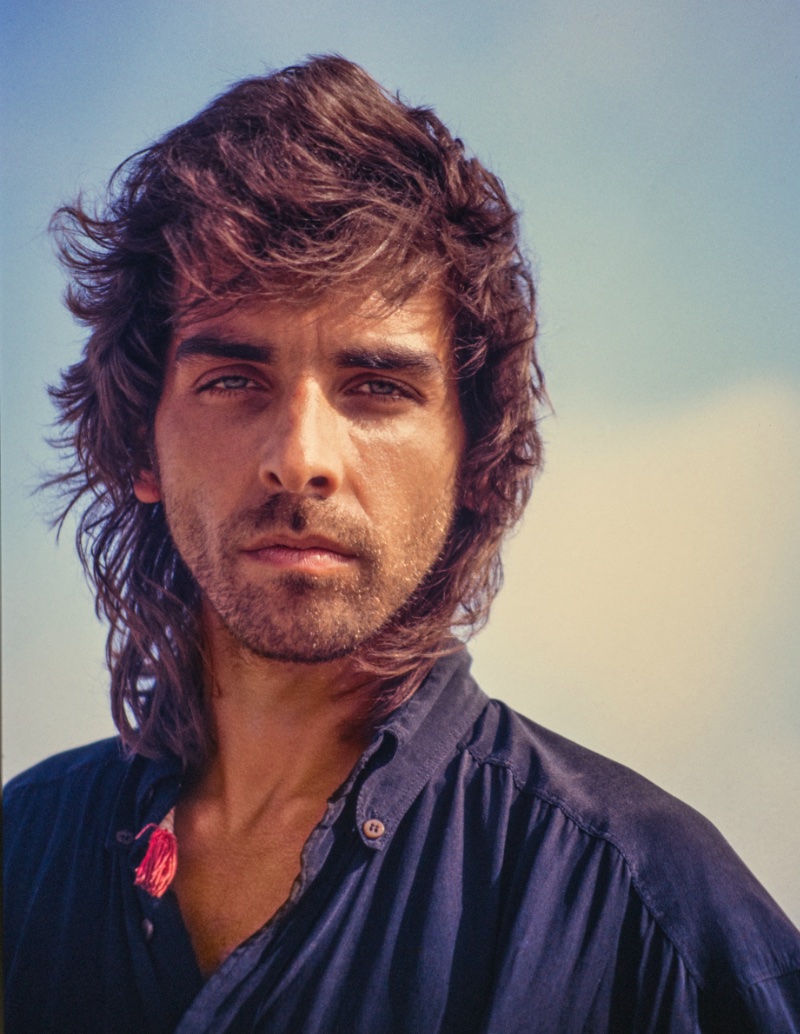
A feathered mullet captures a retro vibe with soft layers that sweep away from the face and length that falls past the collar. The cut relies on airy texture, letting the ends flick outward in a windswept finish that recalls the golden era of late ‘70s rock and early ‘80s Hollywood.
The feathered approach flatters straight and wavy hair, keeping the silhouette light while the mullet’s longer back holds onto its classic attitude. A blow dryer and a round brush accentuate the feathered shape, adding volume and a touch of nostalgia.
Famous Mullets
Famous mullets have shaped pop culture, from the wild charisma of rock stars to the easy confidence of today’s celebrities. The trending mullet takes cues from these icons, constantly reinventing itself for a new generation.
Billy Ray Cyrus
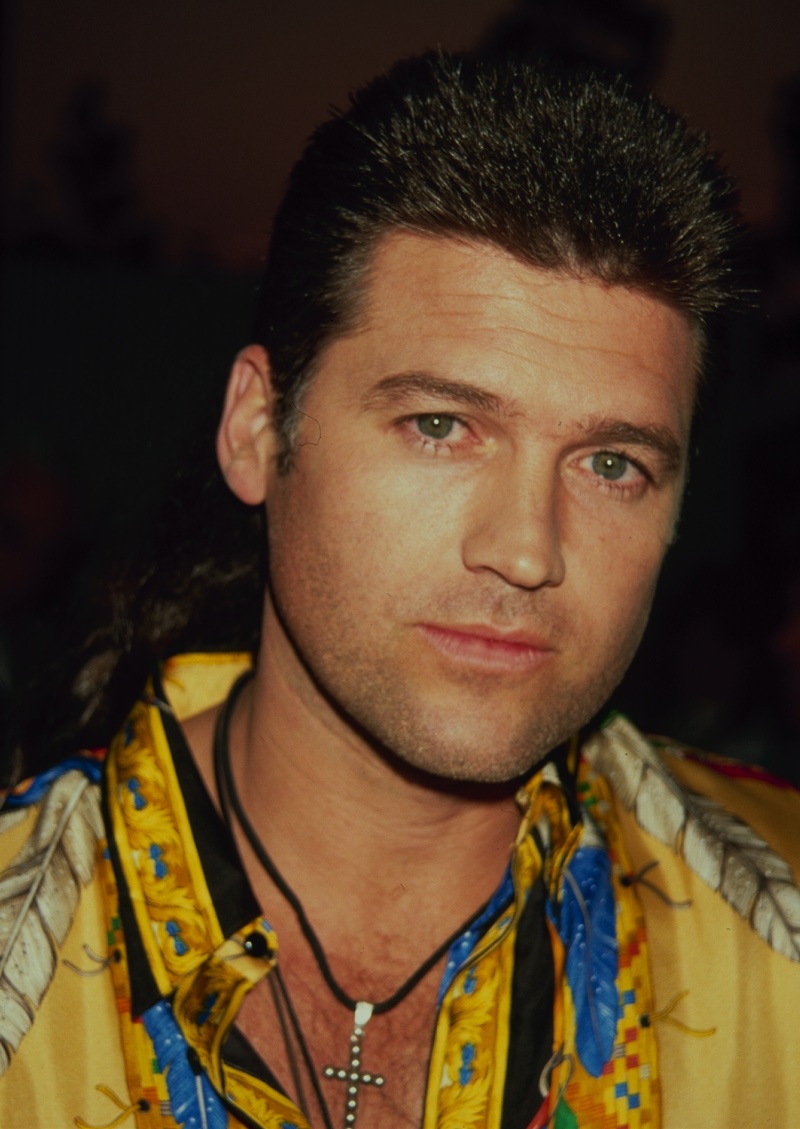
Billy Ray Cyrus’ mullet remains one of the most recognizable 90s haircuts for men, especially in the country music scene. His old school mullet paired a voluminous, textured top with a long, full back that became inseparable from his image during the peak of Achy Breaky Heart.
The style captured the defiant spirit of country music and its celebration of individuality. More than a haircut, the Billy Ray Cyrus mullet became part of his stage presence, turning into a pop culture landmark that defined an era.
Brad Pitt
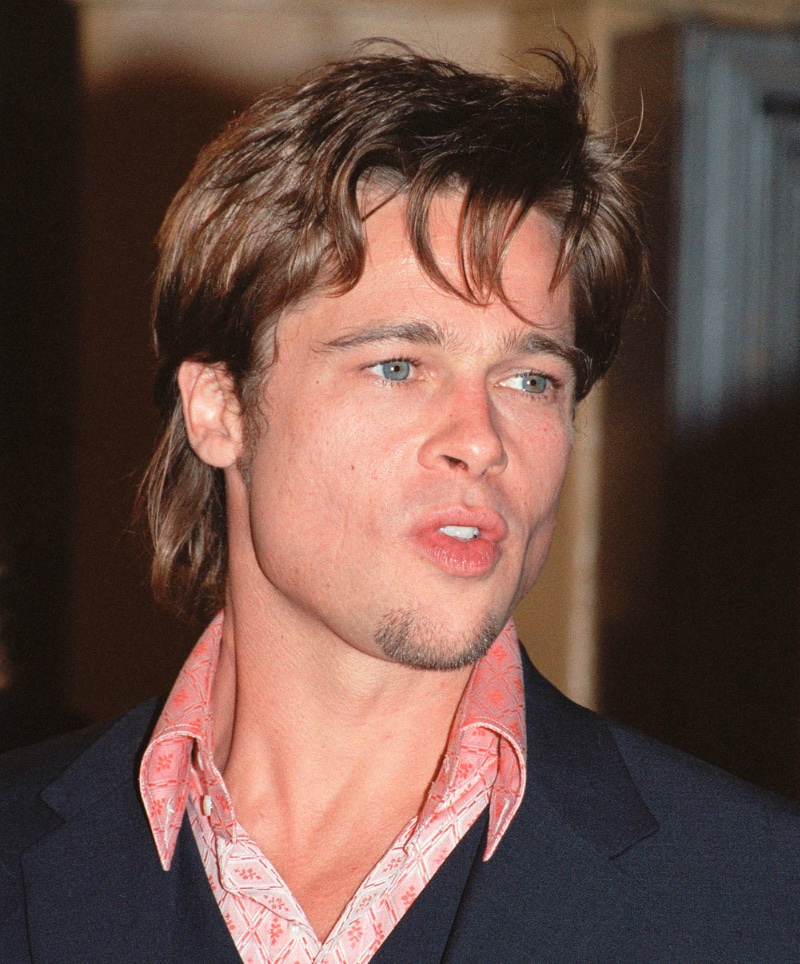
Brad Pitt, the quintessential Hollywood star, has sported various hairstyles throughout his career, each becoming a cultural touchstone in its own right. In 1999, Pitt’s hairstyle married the casualness of a mullet with the polished aesthetic of mainstream celebrity fashion.
This look captured the essence of the late ’90s: a period marked by a relaxed approach to traditional glamour and a growing preference for personal expression in style.
Pitt’s mullet from this era was not as extreme as the classic mullets of the past, but it still featured the defining elements: shorter hair at the front and sides with length at the back. What made Pitt’s version stand out was its textured, layered look, which added a touch of sophistication to the otherwise casual hairstyle.
David Bowie
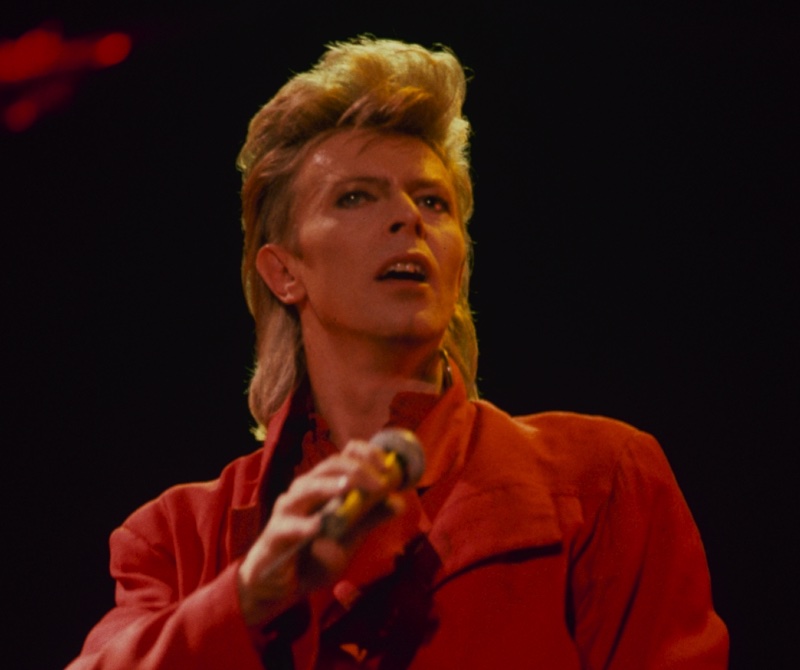
David Bowie, the chameleon of rock, sported various iconic looks throughout his illustrious career, each accompanying a different musical era. In 1987, his mullet had evolved from the vibrant red Ziggy Stardust era to a more subdued style, yet it still retained that unmistakable Bowie flair.
This mullet was softer, with a natural color, and although it was less theatrical, it remained a symbol of his constant reinvention and artistic expression. Bowie’s mullet at this time reflected the changes in his music and personal style, showcasing a more mature and refined aesthetic while maintaining the edge and innovation he was known for.
Jacob Elordi
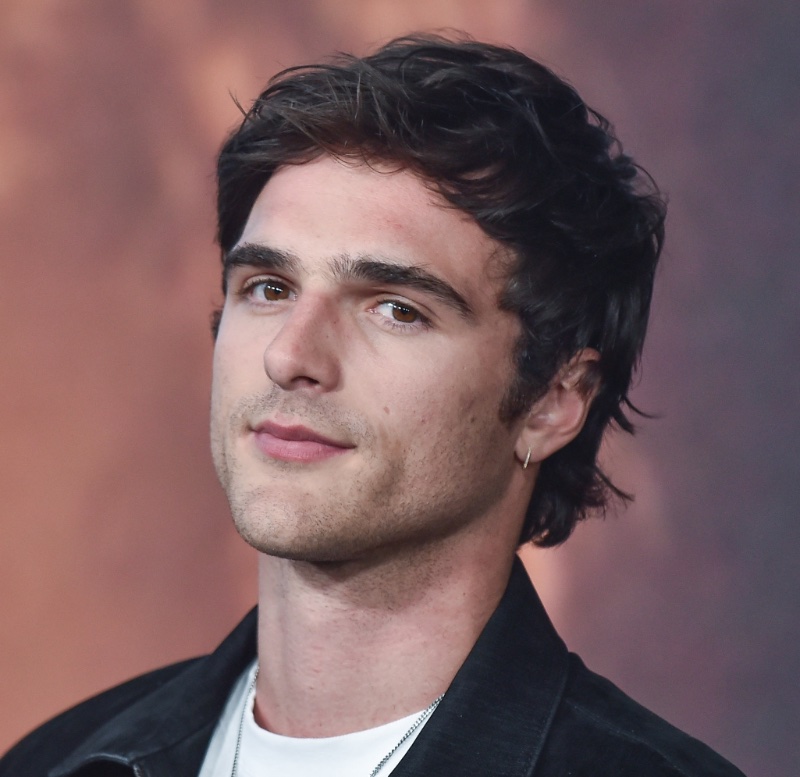
Jacob Elordi, best known for his roles in Euphoria and Saltburn, carries the mullet with a modern finesse that resonates with Gen Z. His take on the hairstyle is less about nostalgia and more about reinvention, crafting a current and charismatic look.
Elordi’s shaggy mullet features a softer texture and a natural flow, moving away from the stark contrasts traditionally associated with the style. It’s a more subdued interpretation, offering a versatile look that can transition from on-screen roles to the red carpet.
Joe Keery
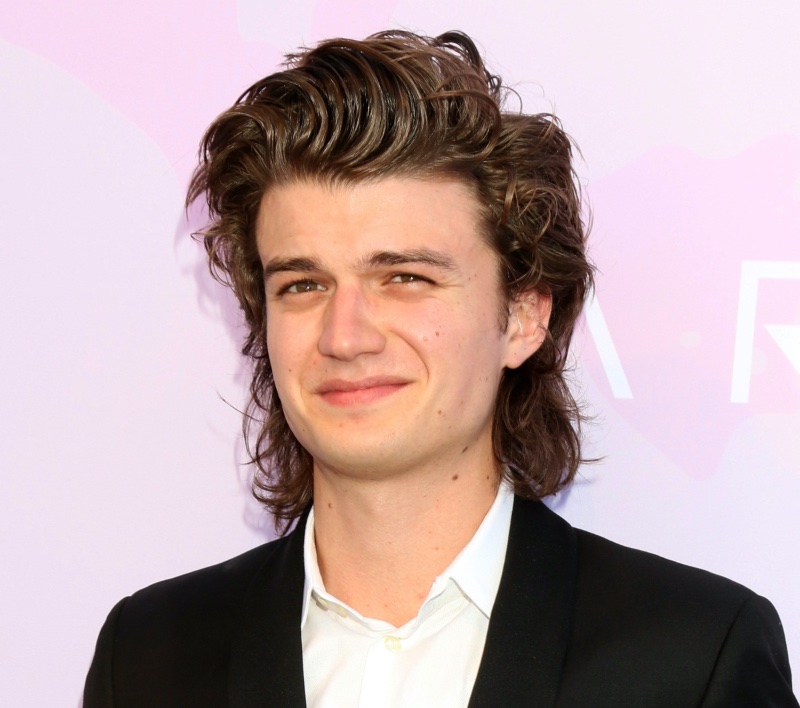
Joe Keery, known for his role in the hit series Stranger Things, has become as well-known for his distinctive hair as his acting prowess. His modern interpretation of the mullet balances retro and current hair trends, characterized by voluminous waves that sweep back into a more subdued, textured flow down the neck.
This contemporary version of the mullet is less about stark contrasts and more about a seamless gradation that offers a nod to the past while firmly grounding itself in the present. Keery’s hair reflects his character’s development and the broader 1980s nostalgia that Stranger Things encapsulates, yet it also has a timeless quality that transcends the show’s setting.
Paul Mescal
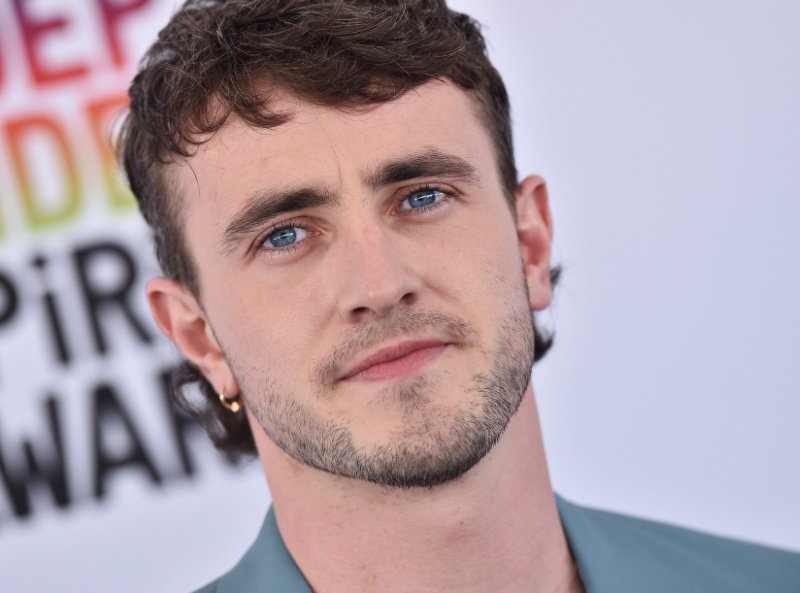
Paul Mescal, the breakthrough actor whose performances have garnered critical acclaim, has adopted not just any mullet but one reimagined for today’s fashion sensibilities. His take on this iconic haircut softens the typically stark contrast of lengths, showcasing a more graduated transition.
The gentle waves of his hair are meticulously styled to create texture. Mescal’s interpretation is in harmony with current trends, striking a delicate balance between homage and evolution. The mullet, once seen as a relic of the past, is now celebrated as a versatile and fashionable choice, thanks partly to Mescal’s refined style.
Embracing the Modern Mullet Haircut
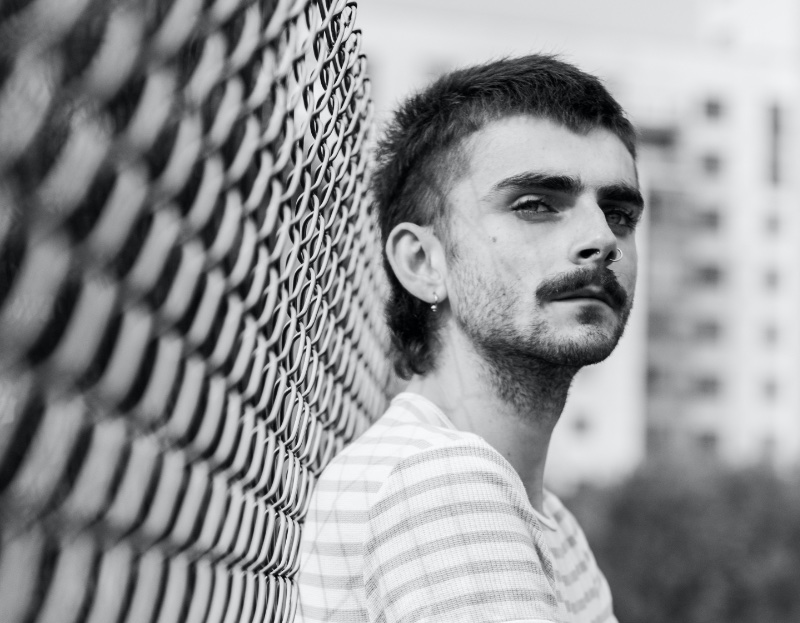
The journey of the mullet haircut, from its heyday in the hands of celebrities to its resurgence in contemporary fashion, is a narrative of reinvention and enduring appeal. This hairstyle, often the subject of both admiration and debate, has proven its versatility and adaptability, maintaining relevance in an ever-changing world of style.
The mullet’s ability to morph with the times, taking on new textures and forms, underscores its status as a symbol of individuality and collective fashion memory. The ideal mullet inspires and challenges in all its styles, inviting men to explore and express their unique styles.
